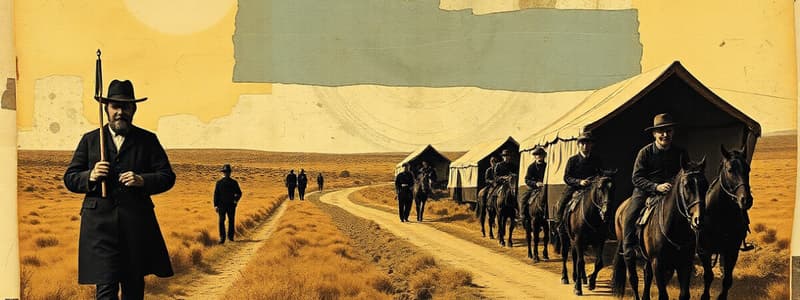Podcast
Questions and Answers
What was the primary incentive offered by the American government to encourage westward migration to Oregon in the 1830s?
What was the primary incentive offered by the American government to encourage westward migration to Oregon in the 1830s?
- Protection from British territorial claims.
- Free land grants to settlers. (correct)
- Guaranteed gold discoveries in the region.
- Subsidized transportation via railways.
Approximately how long was the Oregon Trail, from its starting point in Missouri to its destination?
Approximately how long was the Oregon Trail, from its starting point in Missouri to its destination?
- 500 miles
- 3,500 miles
- 1,000 miles
- 2,000 miles (correct)
What was the typical mode of transportation for settlers traveling along the Oregon Trail?
What was the typical mode of transportation for settlers traveling along the Oregon Trail?
- Steamboats along rivers and canals.
- Railroad cars on newly constructed tracks.
- Covered wagons pulled by oxen, horses, or mules. (correct)
- Stagecoaches pulled by teams of horses.
Why did Oregon Trail travelers typically walk alongside their wagons for much of the journey?
Why did Oregon Trail travelers typically walk alongside their wagons for much of the journey?
What was the primary reason settlers traveling the Oregon Trail formed wagon trains?
What was the primary reason settlers traveling the Oregon Trail formed wagon trains?
How did wagon trains typically arrange their wagons at night for safety?
How did wagon trains typically arrange their wagons at night for safety?
What was a significant challenge faced by travelers when crossing the plains on the Oregon Trail?
What was a significant challenge faced by travelers when crossing the plains on the Oregon Trail?
Why was Independence Rock considered a crucial landmark for Oregon Trail travelers?
Why was Independence Rock considered a crucial landmark for Oregon Trail travelers?
What was the primary geographical feature of the plains that posed a challenge to Oregon Trail travelers?
What was the primary geographical feature of the plains that posed a challenge to Oregon Trail travelers?
Besides Chimney Rock and Independence Rock, what other types of landmarks were important for navigation on the Oregon Trail?
Besides Chimney Rock and Independence Rock, what other types of landmarks were important for navigation on the Oregon Trail?
Flashcards
What was the Oregon Trail?
What was the Oregon Trail?
The Oregon Trail was a historic route that stretched over 2,000 miles from Missouri to Oregon, primarily used by settlers in the 1800s to reach the Pacific Northwest.
Why did people travel the Oregon Trail?
Why did people travel the Oregon Trail?
The American government gave away free land in the Oregon territory to encourage people to settle there and establish American control.
What were the challenges of traveling the Oregon Trail?
What were the challenges of traveling the Oregon Trail?
The Oregon Trail was a dangerous and demanding journey, taking approximately five months to complete, with challenges like scorching heat, treacherous river crossings, and potential attacks from Native Americans.
How did people travel the Oregon Trail?
How did people travel the Oregon Trail?
Signup and view all the flashcards
Describe the mode of transportation used on the Oregon Trail.
Describe the mode of transportation used on the Oregon Trail.
Signup and view all the flashcards
Why did settlers gather in Missouri before starting their journey?
Why did settlers gather in Missouri before starting their journey?
Signup and view all the flashcards
How did travelers protect themselves at night on the Oregon Trail?
How did travelers protect themselves at night on the Oregon Trail?
Signup and view all the flashcards
Describe the Great Plains section of the Oregon Trail.
Describe the Great Plains section of the Oregon Trail.
Signup and view all the flashcards
How did travelers cross rivers on the Oregon Trail?
How did travelers cross rivers on the Oregon Trail?
Signup and view all the flashcards
What were some landmarks on the Oregon Trail?
What were some landmarks on the Oregon Trail?
Signup and view all the flashcards
Study Notes
Oregon Trail Migration
- Dispute over Oregon Territory: In the 1830s, the US and England were disputing control of the Oregon Territory.
- Land Incentive: The US government offered free land to encourage settlement, aiming to claim the territory.
- Motivations for Migration: Settlers sought independence and ownership of land.
- Migration Route: The Oregon Trail, approximately 2,000 miles long, started in Missouri.
- Travel Time: The journey typically took about five months completed.
- Travel Mode: Covered wagons pulled by oxen, horses, or mules were the primary mode of transport.
- Wagon Train Formations: Settlers journeyed in groups (wagon trains) for safety against Native Americans, accidents, and injuries.
- Wagon Train Organization Wagons were arranged in a circle at night for safety.
Oregon Trail Journey Stages
- Plains Travel: The initial leg was across vast, flat, grassy plains. Water scarcity was a significant risk.
- Water Challenges: Finding fresh water was perilous in the plains, with scarce shade or trees for protection from the heat.
- River Crossings: Wagons and animals frequently had to be taken across rivers without bridges.
- Landmarks: Chimney Rock and Independence Rock served as significant landmarks.
- Independence Rock Significance: Crossing Independence rock before Independence Day was crucial to avoid the snow blocking mountain passages.
Rocky Mountains Passage
- Mountain Hazards: The Rocky Mountains presented immense dangers, especially to weary travelers.
- Wagon Lightening: Passengers often had to leave equipment and supplies behind to lighten the load of the wagons and allow animals to traverse more easily.
Oregon Trail Arrival
- Oregon City as Destination: Oregon City was the final destination, where settlers claimed their land.
- Loss of Life: Many settlers died along the trail from accidents, disease, or drowning.
Studying That Suits You
Use AI to generate personalized quizzes and flashcards to suit your learning preferences.




